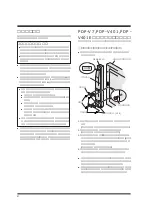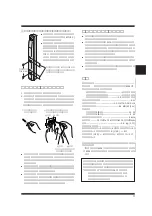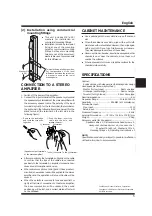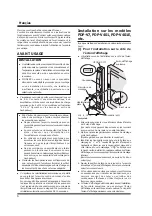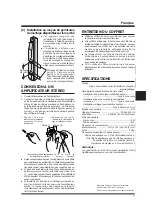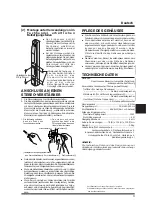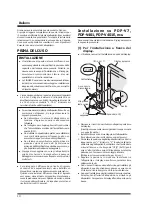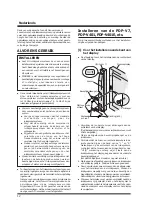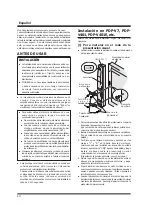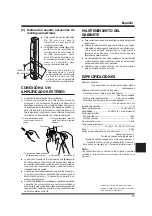
5
CABINET MAINTENANCE
÷
Use a polishing cloth or dry cloth to wipe off dust and
dirt.
÷
When the cabinet is very dirty, wipe with a soft cloth
moistened with water-diluted cleanser; then wipe again
with a dry cloth. Do not use furniture wax or cleaners.
They may damage the surface of the cabinet.
÷
Never use thinner, benzine, insecticide sprays and other
chemicals on or near the cabinets, since these will
corrode the surfaces.
÷
When a chemical cloth is used, read the cautions for the
chemical cloth carefully.
English
[2] Installation using commercial
mounting fittings
÷
This unit includes M8 (ø 25)
washers for installation on
commercial mounting fittings.
÷
Installation is made by two-point
fixing at one of the mounting
holes for commercial mounting
fittings. As these two mounting
holes are not at the same level,
washers are used to compensate
for this difference.
÷
After connection to the terminals, pull lightly on the cable
to confirm that the tips of the cable are connected
positively to the terminals. An imperfect connection can
cause sound interruptions and noise.
÷
When cable cores stick out and
ª
and
·
lines are short-
circuited, an excessive load will be applied to the stereo
amplifier and the operation will stop or trouble will be
caused.
÷
When the polarity is reversed for one speaker (left or
right) at the time of connection to the stereo amplifier,
the bass reproduction will be reduced, the sound
positioning will be lost, and a correct stereo effect will
not be obtained.
Two-point fixing at either position.
For compensation of the level
difference between the two holes,
a washer is used at the lower
monting hole.
SPECIFICATIONS
Cabinet :
Enclosed type with stagger circuit, antimagnetic design
Used speakers (three-way method) :
Woofer (for low tones) ........................... Oval cone type
Mid-range (middle range) ....................... Oval cone type
Tweeter (for high tones) .................... 2.5 cm dome type
Nominal impedance ..................................................... 8
Ω
Frequency Range ..................................... 50 to 60,000 Hz
Sensitivity ................................ 82 dB/W (at 1 m distance)
Permissible input :
Max. input ............................................................... 12 W
Rated input .............................................................. 4 W
Crossover frequency ................................................ 4 kHz
External Dimensions ........ 74 (W) x 714 (H) x 103 (D) mm
Weight ..................................................................... 2.9 kg
Accessory parts (for 2 speakers) . ................................... ..
Speaker cable x 2, Flat countersunk head screw x 4,
Hexagon socket head screw x 4, Hex wrench x 1,
Washer M8 (ø 25) x 4, Washer (ø 15) x 4,
Mounting fittings x 4, Opareting Instructions x 1
NOTE:
Specifications and design subject to possible modfication
without notice, due to improvements.
CONNECTION TO A STEREO
AMPLIFIER
1. Switch off the power of the amplifier.
2. Connect the input terminals of the speaker system and
the speaker output terminals of the stereo amplifier with
the accessory speaker cable. The polarity of the input
terminals is plus
ª
for the red terminal (the terminal on
the right side in the following figure) and minus
·
for the
black terminal (the terminal on the left side in the
following figure).
To the
·
terminal To the
ª
terminal
(Speaker output terminals
of the stereo amplifier)
ª
terminal
·
terminal
2
Push the lever, insert the
cable into the hole, and
release the lever.
1
Remove the insulation
and twist the core ends
together.
Published by Pioneer Electronic Corporation.
Copyright © 1998 Pioneer Electronic Corporation.
All rights reserved.
Washer M8
(ø 25)


